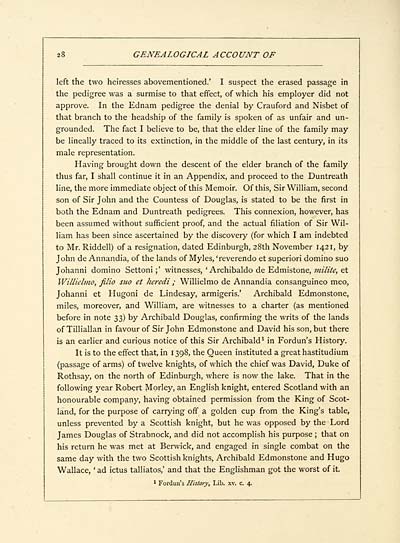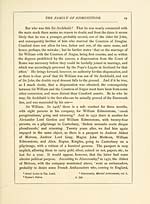Genealogical account of the family of Edmonstone of Duntreath
(46) Page 28 - Sir Archibald Edmonstone --- 1421
Download files
Complete book:
Individual page:
Thumbnail gallery: Grid view | List view

28 GENEALOGICAL ACCOUNT OF
left the two heiresses abovementioned.' I suspect the erased passage in
the pedigree was a surmise to that effect, of which his employer did not
approve. In the Ednam pedigree the denial by Crauford and Nisbet of
that branch to the headship of the family is spoken of as unfair and un-
grounded. The fact I believe to be, that the elder line of the family may
be lineally traced to its extinction, in the middle of the last century, in its
male representation.
Having brought down the descent of the elder branch of the family
thus far, I shall continue it in an Appendix, and proceed to the Duntreath
line, the more immediate object of this Memoir. Of this, Sir William, second
son of Sir John and the Countess of Douglas, is stated to be the first in
both the Ednam and Duntreath pedigrees. This connexion, however, has
been assumed without sufficient proof, and the actual filiation of Sir Wil-
liam has been since ascertained by the discovery (for which I am indebted
to Mr. Riddell) of a resignation, dated Edinburgh, 28th November 1421, by
John de Annandia, of the lands of Myles, 'reverendo et superiori domino suo
Johanni domino Settoni ;' witnesses, 'Archibaldo de Edmistone, milite, et
WiUielmo, filio suo et heredi ; Willielmo de Annandia consanguineo meo,
Johanni et Hugoni de Lindesay, armigeris.' Archibald Edmonstone,
miles, moreover, and William, are witnesses to a charter (as mentioned
before in note 33) by Archibald Douglas, confirming the writs of the lands
ofTilliallan in favour of Sir John Edmonstone and David his son, but there
is an earlier and curious notice of this Sir Archibald 1 in Fordun's History.
It is to the effect that, in 1398, the Queen instituted a great hastitudium
(passage of arms) of twelve knights, of which the chief was David, Duke of
Rothsay, on the north of Edinburgh, where is now the lake. That in the
following year Robert Morley, an English knight, entered Scotland with an
honourable company, having obtained permission from the King of Scot-
land, for the purpose of carrying off a golden cup from the King's table,
unless prevented by a Scottish knight, but he was opposed by the Lord
James Douglas of Strabnock, and did not accomplish his purpose ; that on
his return he was met at Berwick, and engaged in single combat on the
same day with the two Scottish knights, Archibald Edmonstone and Hugo
Wallace, ' ad ictus talliatos,' and that the Englishman got the worst of it.
1 Fordun's History, Lib. xv. c. 4.
left the two heiresses abovementioned.' I suspect the erased passage in
the pedigree was a surmise to that effect, of which his employer did not
approve. In the Ednam pedigree the denial by Crauford and Nisbet of
that branch to the headship of the family is spoken of as unfair and un-
grounded. The fact I believe to be, that the elder line of the family may
be lineally traced to its extinction, in the middle of the last century, in its
male representation.
Having brought down the descent of the elder branch of the family
thus far, I shall continue it in an Appendix, and proceed to the Duntreath
line, the more immediate object of this Memoir. Of this, Sir William, second
son of Sir John and the Countess of Douglas, is stated to be the first in
both the Ednam and Duntreath pedigrees. This connexion, however, has
been assumed without sufficient proof, and the actual filiation of Sir Wil-
liam has been since ascertained by the discovery (for which I am indebted
to Mr. Riddell) of a resignation, dated Edinburgh, 28th November 1421, by
John de Annandia, of the lands of Myles, 'reverendo et superiori domino suo
Johanni domino Settoni ;' witnesses, 'Archibaldo de Edmistone, milite, et
WiUielmo, filio suo et heredi ; Willielmo de Annandia consanguineo meo,
Johanni et Hugoni de Lindesay, armigeris.' Archibald Edmonstone,
miles, moreover, and William, are witnesses to a charter (as mentioned
before in note 33) by Archibald Douglas, confirming the writs of the lands
ofTilliallan in favour of Sir John Edmonstone and David his son, but there
is an earlier and curious notice of this Sir Archibald 1 in Fordun's History.
It is to the effect that, in 1398, the Queen instituted a great hastitudium
(passage of arms) of twelve knights, of which the chief was David, Duke of
Rothsay, on the north of Edinburgh, where is now the lake. That in the
following year Robert Morley, an English knight, entered Scotland with an
honourable company, having obtained permission from the King of Scot-
land, for the purpose of carrying off a golden cup from the King's table,
unless prevented by a Scottish knight, but he was opposed by the Lord
James Douglas of Strabnock, and did not accomplish his purpose ; that on
his return he was met at Berwick, and engaged in single combat on the
same day with the two Scottish knights, Archibald Edmonstone and Hugo
Wallace, ' ad ictus talliatos,' and that the Englishman got the worst of it.
1 Fordun's History, Lib. xv. c. 4.
Set display mode to:
![]() Universal Viewer |
Universal Viewer | ![]() Mirador |
Large image | Transcription
Mirador |
Large image | Transcription
Images and transcriptions on this page, including medium image downloads, may be used under the Creative Commons Attribution 4.0 International Licence unless otherwise stated. ![]()
| Histories of Scottish families > Genealogical account of the family of Edmonstone of Duntreath > (46) Page 28 - Sir Archibald Edmonstone --- 1421 |
|---|
| Permanent URL | https://digital.nls.uk/95354007 |
|---|
| Description | A selection of almost 400 printed items relating to the history of Scottish families, mostly dating from the 19th and early 20th centuries. Includes memoirs, genealogies and clan histories, with a few produced by emigrant families. The earliest family history goes back to AD 916. |
|---|

